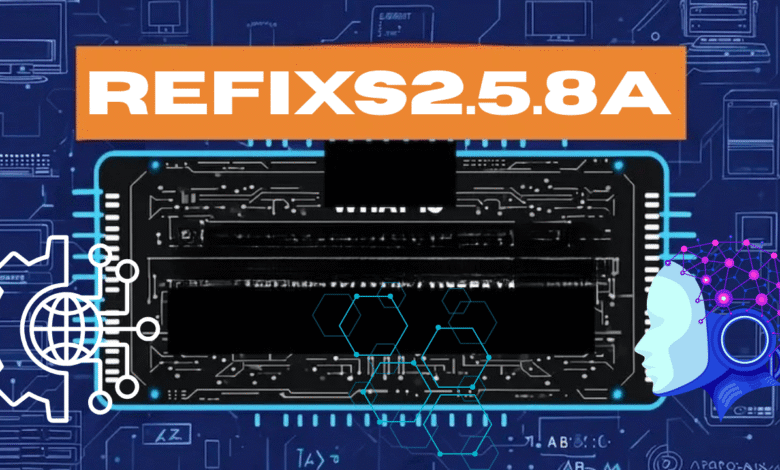refixs2.5.8a: A Complete Guide — What It Does, What’s New, and How to Use It Safely

Refixs2.5.8a is a recent update to a system utility designed to improve performance, stability, and security on personal computers and workstations. This guide explains what refixs2.5.8a does, which improvements to expect, how to install it safely, and practical tips for getting the best results. Read on if you plan to write about refixs2.5.8a for a blog or want a clear, user-friendly reference to help readers decide whether to upgrade.
What refixs2.5.8a is and why it matters
Refixs2.5.8a combines diagnostic tools, performance optimizers, and security patches in one package. Many users install it to address slowdowns, recurring errors, or unexplained crashes. For content creators and blog readers who care about maintaining a healthy machine, refixs2.5.8a promises tangible improvements in everyday responsiveness and fewer interruptions.
Key reasons refixs2.5.8a matters:
- It bundles maintenance tasks that otherwise require multiple utilities.
- It targets both performance and security, which is useful for home and business users.
- It introduces usability tweaks that make system diagnostics easier to interpret.
Major improvements in refixs2.5.8a
Performance optimizations
One of the headline changes in refixs2.5.8a is more efficient handling of background processes and memory allocation. Users who multitask—running editors, browsers, and media tools simultaneously—should notice smoother behavior after a clean install.
Common performance gains reported with refixs2.5.8a:
- Reduced memory bloat over long sessions
- Faster context switches when opening and closing apps
- Improved responsiveness under moderate CPU load
Stability and crash prevention
Refixs2.5.8a includes fixes to several known crash triggers. Logs and diagnostic traces are clearer, helping users and technicians identify recurring faults. That clarity reduces the time spent troubleshooting and increases uptime for critical tasks.
Stability highlights:
- Better error handling for problematic drivers
- Fewer unexplained freezes during heavy I/O
- Cleaner recovery after an unexpected shutdown
Security enhancements
Security is a key focus. Refixs2.5.8a tightens update mechanisms and strengthens logging for suspicious activity. These changes reduce the risk of running outdated or tampered components and help administrators verify system integrity more quickly.
Security points to emphasize:
- Hardening of update verification steps
- More detailed audit logs for system events
- Patches for previously reported vulnerabilities
Who benefits most from refixs2.5.8a
Home users and casual power users
If a reader notices sluggish performance after several years of use, refixs2.5.8a can be a worthwhile step before buying new hardware. It often yields visible improvements on machines that have accumulated software cruft.
Small business and IT administrators
For administrators, refixs2.5.8a’s improved diagnostics and stability reduce maintenance time and lower the chance of service interruptions. The security improvements make it a reasonable update to include in routine patch cycles.
Creators and resource-heavy users
People who edit video, render 3D scenes, or run virtual machines will appreciate the memory and process management tweaks in refixs2.5.8a.
Installation and upgrade best practices for refixs2.5.8a
Prepare before you install
- Create a full backup of important files and system settings.
- Verify system restore or snapshot functionality is enabled.
- Check minimum system requirements (CPU, RAM, disk space) and free up space if needed.
Safe upgrade steps
- Download refixs2.5.8a only from the official distributor or a trusted source.
- Turn off nonessential background applications before starting the installer.
- Follow on-screen instructions and choose a custom install if you want to control optional modules.
- Reboot and run an initial diagnostic scan after installation.
Post-install checks
- Verify system responsiveness with a simple benchmark or everyday tasks.
- Review the updated logs to ensure no unexpected warnings.
- If issues appear, roll back to the previous snapshot and consult support channels.
Practical tips and quick wins with refixs2.5.8a
Use the following checklist to maximize benefits after installing refixs2.5.8a:
- Run a full system scan within 24 hours of installation.
- Schedule weekly maintenance tasks using the built-in scheduler.
- Keep automatic updates enabled to receive subsequent patches.
- Use the diagnostic logs to identify third-party software that might conflict.
Quick optimization points:
- Disable unnecessary startup programs.
- Clean temporary files to free disk space.
- Update hardware drivers that remain outdated after installation.
Common problems and troubleshooting for refixs2.5.8a
If performance worsens after install
- Reboot and run the diagnostic tool in the utility to check for misapplied settings.
- Temporarily disable optional modules to isolate the cause.
- Restore the system snapshot if problems persist.
If new warnings appear in logs
- Carefully read the log entries and search for specific error codes.
- Check that third-party drivers are compatible with refixs2.5.8a.
- Contact official support if a critical error cannot be resolved.
When downloads fail or updates stall
- Confirm sufficient disk space and a reliable internet connection.
- Verify the download file checksum, if provided, to rule out corruption.
- Use a manual update option if automatic updates fail repeatedly.
How refixs2.5.8a compares to other optimization tools
Refixs2.5.8a aims to combine several functions that users otherwise get from multiple standalone utilities. Compared to single-purpose tools, refixs2.5.8a’s advantage is convenience and integrated diagnostics. Compared to full enterprise suites, it is lighter and easier to deploy on individual machines.
Comparison considerations:
- Feature breadth versus depth (all-in-one vs specialized tools)
- Resource footprint during scans and maintenance
- Quality of diagnostic reporting and clarity of recommended fixes
Sample article angles you can use for a blog
Here are a few topic ideas tailored to different audiences and content goals:
- How refixs2.5.8a can revive an older laptop: step-by-step upgrade guide
- Top five ways refixs2.5.8a improves performance for creators
- An admin’s checklist for rolling out refixs2.5.8a across a small network
- Real user experiences: before and after refixs2.5.8a (case study style)
Each angle can be expanded into an evergreen post with screenshots, step-by-step instructions, and simple benchmarks to show real-world improvements.
Key takeaways about refixs2.5.8a
- Refixs2.5.8a targets three core needs: performance, stability, and security.
- It is most useful for users who want an integrated maintenance solution without several separate tools.
- Safe installation practices and backups are essential before upgrading.
- Troubleshooting is typically straightforward thanks to improved diagnostics.
Conclusion
Refixs2.5.8a represents a practical maintenance update that balances usability with technical depth. For writers preparing a blog post, focusing on hands-on guidance, clear upgrade instructions, and honest discussion of possible caveats will make the article both useful and credible. Whether readers are casual users, creators, or small business administrators, refixs2.5.8a is worth covering because it addresses everyday issues—slowness, crashes, and security gaps—that many people face. Conclude your article with a simple checklist and a short troubleshooting guide so readers feel empowered to try refixs2.5.8a with confidence.



